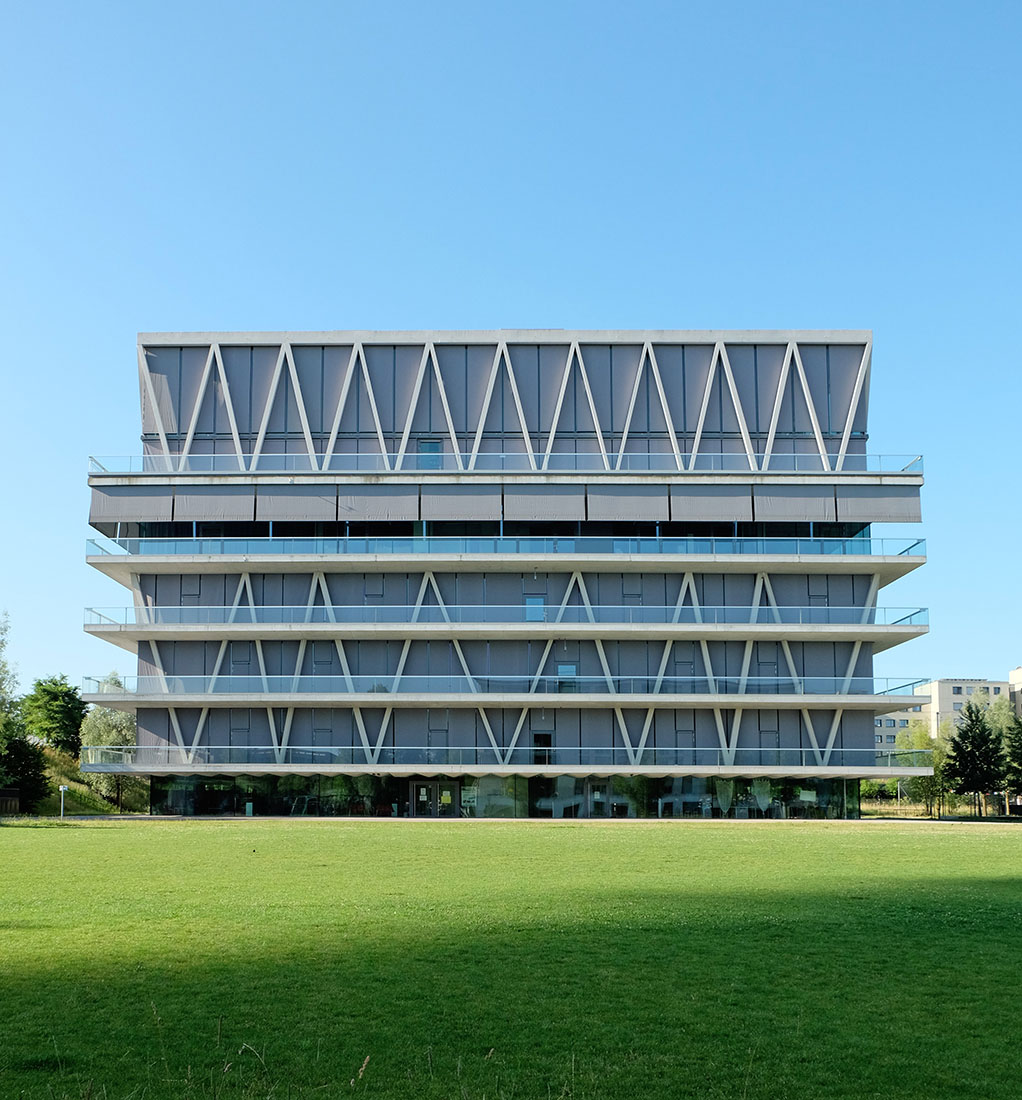 |
 |
 |
 |

School Building Leutschenbach
Saatlenfussweg 3, Zürich
2002 - 2009
Situated between industrial, commercial and residential buildings, the new school building is a reference to the larger scale of these buildings. The building seems to float above the ground, reflects the sky and impacts on its surroundings without being dominant. The school building acts as a termination of the new Andreaspark, which extends along the suburban railway line. The extensive parking area serves the entire district as a valorization.
The sophisticated building structure explores the limits of the statically possible, and resulted in a complex construction process. The construction started in May 2005; the construction period was extended to four years by several delays. The steel structure was considered to be a part of the structure and was a major challenge. The steel structure took a long time to settle. For the ingenious static concept, it was important to reduce the weight of the ceilings as far as possible. This was achieved by the use of light-weight concrete on the one hand, and by shaping on the other. The profile of the ceilings has been optimized in a static way so that the lower surfaces appear as folded surfaces. When the building was officially inaugurated on September 7, 2009, the aspiring city district of Leutschenbach received the urgently needed schoolhouse. At the time of opening it was the second largest school house of the city of Zurich. Already during the construction process the school house attracted great interest and after the completion the building polarized.
Das Schulhaus Leutschenbach ist das Resultat aus einem zweistufigen Architekturwettbewerb, welcher 2002 ausgeschrieben wurde, und wurde für alle Altersstufen, vom Kindergarten bis zur Oberstufe, konzipiert. Der Architekt Christian Kerez gewann den Wettbewerb mit einem aussergewöhnlichen Vorschlag. Um die Grosszügigkeit der Parzelle zu bewahren, wurden alle Innenräume des Gebäudes auf den kleinsten gemeinsamen Nenner reduziert und übereinader gestapelt. Das Gebäude entwickelt sich in die Höhe, wodurch ein möglichst geringen Fussabdruck für das grosse Volumen erreicht werden konnte. Die gestappelten Räume unterschieden sich in Grösse und Höhe, wobei sie das räumliche und architektonische Gesamtkonzept variieren. Die öffentlichen Nutzungen wurden dabei in Zwischengeschossen untergebracht. In diesen Zwischengeschossen wir die Statik auf den inneren Bereich reduziert, so dass uneingeschränkter Ausblick gewährleistet wird. Eine dreistöckige Fachwerkkonstruktion aus Stahl nimmt die Klassenzimmer auf. Die unterteilbare Turnhalle weist in etwa die selbe Höhe auf, und wird von einer kontinuierlichen Rahmenstruktur umgeben, welche jener der Klassenräume ähnlich sieht. Ungewöhnlicherweise befindet sich die Turnhalle als grösster und höchster Raum zuoberst auf dem Gebäude, und erscheint als Bekrönung. Im Erdgeschoss wird die Gebäudestruktur auf einen minimalen Kernbereich reduziert, und der Innenraum wird lediglich durch eine gläserne Membran von der Umgebung getrennt. Die gesamte Fassade des Klassenraumblocks ist an der Rahmenstruktur des Bodens aufgehängt und bildet dadurch eine Überdeckung, welche rund zehn Meter über den Spielbereich auskragt. Das Grundrisslayout wurde so gewählt dass keine Korridore entstehen. Alle Klassenräume öffen sich direkt zu den grosszügigen Erholungsbereichen. Diese Vorzonen können auch für die Lehrtätigkeiten genutzt werden. Eine grosse Doppeltreppe aus Beton teilt die Grundschule von der weiterführenden Schule und ist in die den Grundriss mit Freizeit- und Klassenzimmer integriert. Die beiden entgegengesetzt verlaufenden Treppen treffen sich im fünften Obergeschoss in einem grossen Foyer. Dieses Foyer gibt Zugang zu allen öffentlichen Funktionen wie der Aula und der Bibliotheke. Die offene Treppenanlage bedingte einen aussenliegenden Fluchtweg, so dass rund um das Gebäude Betonplatten mit Glasbrüstungen verlaufen und an eine Fluchttreppe angeschlossen sind. Das realisierte Gebäude ist als Prototyp zu betrachten, viele Vorgaben und Anforderungen wurden hier auf neue Art und Weise interpretiert. Die reduzierte Materialisierung wird durch Glas und Beton geprägt und gibt dem Gebäude einen engen Zusammenhalt. Transluzentes Profilglas wird anstelle von opaken Konstruktionen für die Raumunteteilung verwendet.
Zwischen Industrie-, Gewerbe- und Wohnbauten gelegen, bezieht sich das neue Schulhaus auf den Massstab dieser Bauten. Der Baukörper scheint über dem Boden zu schweben, wiederspiegelt den Himmel und prägt seine Umgebung ohne dominant zu wirken. Städtebaulich funktioniert das Schulhaus als Abschluss des neuen Andreaspark, welcher sich entlang der S-Bahnlinie erstreckt. Die weitläufige Parkanlage dient dem gesamten Quartier als Aufwertung.
Die ausgeklügelte Gebäudestruktur geht an die Grenzen des statisch möglichen, und resultierte in einem aufwändigen Bauprozess. Im Mai 2005 erfolgte der Baubeginn, durch mehrere Verzögerungen wurde die Bauzeit auf vier Jahre ausgeweitet. Die Stahlkonstruktion ist als Herstück der Struktur zu betrachten, und stellte eine grosse Herausforderung dar. Die Stahlstruktur benötigte viel Zeit bis sie sich genügend gesetzt hatte. Für das ausgeklügelte statische Konzept war es von Bedeutung, das Gewicht der Decken soweit wie möglich zu reduzieren. Dies gelang einerseits durch die Verwendung von Leichtbeton und andererseits durch die Formgebung. Das Profil der Decken wurde statisch optimiert, so dass die Untersichten als gefaltete Oberflächen in Erscheinung treten. Als das Gebäude am 7. September 2009 offiziell eröffnet werden konnte, erhielt der aufstrebende Stadtteil Leutschenbach das dringend benötigte Schulhaus. Zum Zeitpunkt der Eröffnung was es das zweitgrösste Schulhaus der Stadt Zürich. Bereits während dem Bauprozess zog das Schulhaus grosses Interesse auf sich und nach der Fertigstellung polarisierte das Gebäude.
